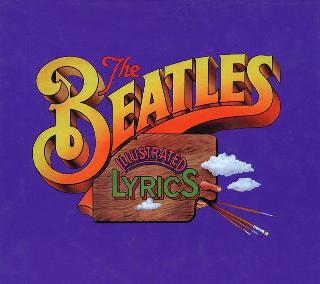

 (c) Alan Aldrigde, The Beatles Illustrated Lyrics
(c) Alan Aldrigde, The Beatles Illustrated LyricsINTRODUCTION
- This beat up 78rpm shellac demo made by the Quarry Men at the Liverpool home studio of one Percy Phillips in 1958 is unlikely to ever be superseded to its claim as the earliest extent recording made by John, Paul, George and some friends.
- In their 1990 book, _Every Little Thing_, authors McCoy and McGeary listed this unique artifact as the first item on a short list of "Beatles Records Most Collectors Will Never Own." While the likelihood of anyone other than Paul possessing this unique item hasn't changed much since then, the release of Anthology I in 1995 made the contents of this rarity available for all to hear.
- Granted, most of the A-side tribute to Buddy Holly's "That'll Be The Day" had leaked out on bootleg some years back. But it's a small miracle this record survives, and I dare say that hearing it in its entirety, the mysterious dark side of the moon B-side included, in official release no less, was something on which very few fans could have counted on before the Anthology.
- So what do we find here? Let's take the two sides in the order that The Boys intended.
SONG-BY-SONG WALKTHROUGH
That'll Be The Day
KEY A Major
METER 4/4
FORM Intro -> Refrain -> Verse -> Refrain -> 12-bar Instrumental ->
Refrain -> Verse -> Refrain -> Outro (w/complete ending)
COMPOSER Allison/Holly/Petty
INFLUENTIAL VERSION Buddy Holly and the Crickets (1957)
- This is a surprisingly faithful cover of Buddy's original especially making generous allowance for the limited technical skills of the group at this point. It's in the same key and form. You can just about imagine them playing it along with the record.
- John takes a stab at Buddy's selectively glottalized vocal delivery, Paul valiantly tries to individually carry the entire burden of the Crickets' choral backing vocals, which alternate between lyrics and phonemic backwash. The lead guitar work is also faithful to the original.
- The form is somewhat unusual dominated by four repeats of a refrain in which the first and third of the inner interludes are verses, and the middle interlude is a 12-bar instrumental.
- The tune is very bluesy, with heavy melodic emphasis on C natural in spite of the C# in the key signature.
The refrain is eight measures long. In terms of harmonic shape, it starts away from I, but proceeds directly toward it, only to open up the ending to V in a last minute small burst of quickened harmonic rhythm:
|D |- |A |- |
A: IV I
|D |- |A |- E A |
IV I V I
- The verse is also eight measures. It starts off with the same chord progression as the verse, thus somewhat blurring the musical distinction between the two sections, in spite of the fact that the harmonic rhythm is generally faster here than in the refrain.
|D |A |D |A |
IV I IV I
|D |A |(B?) |E |
IV I V-of-V V
- The Quarry Men truly were only a "three chord" band at this point. Buddy deploys one more chord, the relatively common V-of-V, toward the end of this section but our guys somewhat bashfully vamp through with E Major in its place.
- Buddy signals the immanent arrival of his outro with a pair of slow triplets in the final verse of the sort would later become a Beatles favorite. The Quarry Men don't pick up on this detail.
- The outro itself is a simple variation on the refrain section and includes touches of falsetto singing of a sort that would eventually appear high up on a list of elements of the early Beatles sound.
- John fails to accurately copy the specific notes Buddy sings for the falsetto, and the backing forces fail to show up for him in the complete ending.
- Still, all and all, it's not a bad cover at all for a bunch of amateur
kids.
In Spite of All the Danger
KEY E Major
METER 4/4
FORM Intro -> Verse -> Verse -> Bridge ->
Verse -> 12-bar Instrumental -> Verse ->
Outro (w/complete ending)
GENERAL POINTS OF INTEREST
- This McCartney and Harrison collaboration turns out to be a surprise, with its moderately slow tempo, and a backbeat and vocal delivery that is possibly bluesy, but even more so rather like some old style American Country & Western caterwauling.
- The form is awkwardly ambitious, not quite fitting any of the standard models we're familiar with. Its closest match would be the two-bridge model with a single verse intervening, except that in place of the second bridge we find an instrumental solo in the form of a 12-bar frame. The outro is a two-fold manque variation on the more familiar three-times-you're- out gambit.
- The lyrics of the four verses contain a common final line, and create an unusually clunky pattern of ABAB. All sections begin with a pickup before the downbeat. The title phrase and opening line of the lyric is unusual both for its sheer length and its manner of leading off which a grammatical subordinate clause. The alternation of "danger" and "heartache" in the first line of the verses anticipates a Beatles wordplay trademark. McCartney and Harrison's authorship notwithstanding, the only time one of the conspicuous title words would ever appear in a song of the Beatles is in one that clearly was written by John.
- The tune has a relatively large amount of chordal outline leaping about. The backing vocal features the descending chromatic line cliche.
- Only three chords are used, no surprise, just I, IV, V. A dominant seventh is frequently added to the I chord in order to exploit its capability of acting like a V-of-IV.
- There's an ensemble of five on the backing track, though it provides little in the way of what you'd call a prepared "arrangement," and the primitive mastering of the track leaves the piano and drums barely audible most of the time.
- John sings the lead vocal. Paul's backing alternates between harmonizing with John in close but standard harmony, and short obbligato licks.
- The backbeat is characterized by rapid triplets though Paul tries with some awkwardness to cast slow triplets against it for his chromatic lick at the end of each line of the verse.
SECTION-BY-SECTION WALKTHROUGH
- The intro is just two measures long but the downbeat is preceded by a guitar pickup that nearly anticipates the jumpiness of the vocal line without actually giving it away.
|E |B |
E: I V
- The verse is eight measures. The harmonic shape is closed at both ends. Even though the key is already clearly established with full cadence through measure 6, the final two measures tack on a textbook Plagal cadence:
|E |- |- |7 |
E: I (V-of-IV)
|A |B |E A |E 7 |
IV V I IV I (V-of-IV)
- The bridge is also eight measures (compare with our A-side song). Here the harmonic shape is open at both ends.
|A |- |E |7 |
IV I (V-of-IV)
|A |- |B |- |
IV V
- The leading off of both phrases with the IV to I chord progression also bears interesting comparison with the A-side. Granted, this device is a relatively garden-variety chord progression used in all kinds of songs, but the correspondence on this detail between the very two songs performed by this group of musicians on a day in 1958 is uncanny.
- The guitar solo is based on a variation of the standard 12-bar blues that provides an open harmonic ending on V.
- The solo is nicely based on lead guitar figuration heard in the intro, or perhaps it's the other way around.
- A stray word of spoken encouragement can be heard in the third measure.
- The outro is based on a petit reprise of final four measures of the verse section with a small vocal flourish to signal that this is the end.
SOME FINAL THOUGHTS
- So when you heard these tracks for the first time was your patient curiosity well rewarded or were you disappointed? The answer depends directly on what you might have been expecting.
- It would be an gross overstatement to say these tracks manifest any clearly prescient foreshadowing of the "greatness" that was to emerge some four or so years later. By the same token I think you'd be precipitant to dismiss them as merely uninteresting or incompetent juvenilia.
- There's certainly enough personality coming through these recordings to recognize the hand of the proto-Beatles in them, at least given perfect hindsight. The performances are comparable with, if not a notch above, the best of the other Quarrymen tracks referred to usually as "Liverpool 1960." Besides, a chance to hear this particular ensemble, which includes Colin Hanton on drums and John "Duff" Lowe on piano, is worth the price of admission on its own historical merits.
- But why should I even have to convince you to enjoy these performances? Perspective is all.
Regards, Alan (awp@world.std.com) --- "For red is the color that will make be blue, in spite of you." 030601#199 --- Revision History 030601 199.0 Original releaseCopyright (c) 1995 by Alan W. Pollack All Rights ReservedThis article may be reproduced, retransmitted, redistributed and otherwise propagated at will, provided that this notice remains intact and in place.